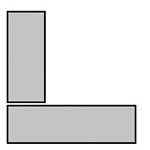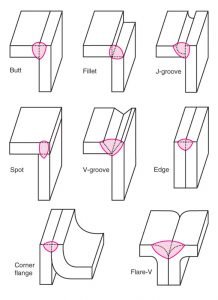Corner Welding Joint
![]()
 Corner Joint
Corner Joint
Being one of the most popular welds in the sheet metal industry the Corner welding joint is used on the outer edge of the piece. This weld is a type of joint that comes together at right angles between two metal parts to form an L. These are common in the construction of boxes, box frames and similar fabrications.
Welding Styles Used To Create Corner Joints:

- Spot weld
- Fillet weld
- V-groove weld
- Square-groove weld or butt weld
- U-groove weld
- Bevel-groove weld
- Flare-V-groove weld
- J-groove weld
- Corner-flange weld.
- Edge weld
A Brief Word On Welding Safety
If you’re just learning or even if you’ve done welding for years it can’t be said enough that it’s critical to be fully aware of your surroundings when you begin to weld. You must take the time to know who’s around trying to watch and what dangers you are exposing yourself to.
Welding vs Riveting
Welding and riveting are two ways to join metal to metal. They both have their particular pros and cons. Different situations call for one or the other. Neither is best for every possible situation. We’ll take a look at the different strengths and weaknesses of both metal joining systems.
Ways Welding Is Better Than Riveting
- Welding can be done anywhere on the structure. Edges can be welded to edges without having to overlap. Riveting needs to have a certain amount of clearance from the edges to be joined.
- Welding saves weight in the construction process. Since metal is actually joined to metal, gussets or other connecting hardware is not needed. Even the rivets themselves have weight, so being able to join the metal together without having to use them saves a bunch of weight.
- Unlike riveted joints the tensions members’ strength is not diminished by welding.
- Quality welding leaves a smooth surface, while riveting has the ends of rivets on the surface of the whole structure. Using welding to produce a strong yet beautifully smooth surface creates our functional but aesthetically pleasing architecture.
- Welded joints are better many times because the material on both sides of the weld is actually physically joined.
- Welding can easily join sections of metal column or pipe. Trying to join these items with rivets can be difficult or impossible given certain situations.
- Welding is a faster way of joining metal. This means that is you have a time sensitive project welding holds the edge. It also means less man hours, which helps save on costs.
- Additions or alterations can easily be made with welding. Structures built with rivets are less flexible and additional engineering is necessary to make these changes with riveting.
Need Welding Services In Mesa, Arizona?
Why not leave it to the professionals at Cliff’s Welding? You will be able to rest assured that the pros have handled your job, big or small to the correct standards and codes to ensure the durability and strength of the welds.
Give us a call at 480-832-0570 or use our Contact Page.
Thank you for visiting “Types Of Welding Joints” post. Stay tuned for more from Cliff’s Welding.
